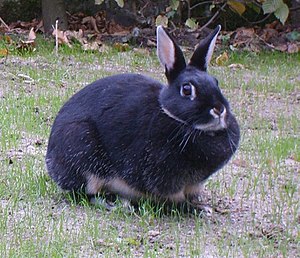White awns
The white awn rabbit is a medium-sized breed of rabbit weighing around 3.5 kg.
Appearance of the white-awn rabbit
In terms of color, the white awn rabbit is characterized by a single-colored, dark top, white belly and underside of the flower. The head drawing includes the white circles under the eyes, white edging of the nostrils, the edging of the jaws and the white edging of the ears that continues in the neck wedge. The white border around the ears should be visible as a small white spot between the ears. The white color of the belly is continued in the form of white awning hair in an approximately hand-wide band on the chest, flanks and rear. This color distribution results from the combination of the tan factor, a mutation of the wild color factor in which the distribution of the color zones in rabbits is canceled, but the typical wild color markings are retained with the chinchilla factor , an allele of the albino series , in which no yellow pigment is formed in the hair . The similar tale rabbit, however, has additional yellow enhancers that lead to the bright yellow color of the badges.
White awn rabbits are recognized in the colors black, blue and Havana, the black color is the most common, the Havana color makes up about 10% of the white awns shown.
The corresponding hereditary formulas are:
- Black: AchiBCDgo (German symbols) or atBCch2DE (English symbols)
- Blue: AchiBCdgo (German symbols) or atBCch2dE (English symbols)
- Havana-colored: AchiBcDgo (German symbols) or atbCch2DE (English symbols)
History of the white awn rabbit
White awn rabbits, like other rabbit breeds, have arisen several times independently of one another. In Germany , Friedrich Joppich was the first to show it in 1928 at the Edelfurztierau in Berlin under the name of the German Silver Fox Rabbit. According to him, animals of this color often appeared in litters, especially English chinchilla rabbits . This is not surprising, as Sandford also mentions the strong splitting of the first chinchilla rabbits and the crossbreeding of tai rabbits . Joppich mentions that various other breeders in Germany and other countries also found rabbits of the color of the white awns in litters of chinchilla rabbits and partially developed them further as independent breeds. In 1933 this breed was recognized as the Zilvervos (silver fox) in the Netherlands . Around Joppich's silver fox rabbits things became quieter again in Germany, the breed was only bred again in Germany after the Second World War, according to Kläre Geißler from Bad Klosterlausnitz , who in 1949 again found two young animals of this drawing in a litter of small chinchilla rabbits and exhibited the breed in 1951. At this time, too, the breed developed independently in various places, for example in Landshut , Pfaffenhofen and Ilmmünster . The information on the recognition of the breed in the standard fluctuates somewhat between 1957 and 1962. Today, white-awn rabbits are common without being very common; Majaura states that in 2004 1.3% of all young animals raised in Germany were white-awn rabbits.
Similar races
The tan rabbit shows a similar distribution of the color fields, but has bright yellow colored markings. In other countries the white awn rabbit is known as the silver fox. (Eng. Silver Fox, Dutch Zilvervos).
The color of the white awn rabbit exists as the color of the color dwarfs .
literature
- W. Schlohlaut: The big book of the rabbit. 2nd Edition. DLG-Verlag, Frankfurt 1998, ISBN 3-7690-0554-6 .
- JC Sandford: The domestic rabbit. 5th edition. Blackwell Science, Oxford 1996, ISBN 0-632-03894-2 .
- F. Joppich: The rabbit. VEB Deutscher Landwirtschaftsverlag, Berlin 1967.
- FK Dorn, G. March: Breed rabbit breeding. 5th edition. Neumann-Verlag, Leipzig / Radebeul 1981.
- H. Majaura: White awns . In: The small animal breeder - rabbit. 7/2000, pp. 4/5, ISSN 1613-6357
Web links
- Markus Eber: Weißgrannen (PDF; 18.7 MB), Entente Européenne d'Aviculture et de Cuniculture judges course, March 2012
